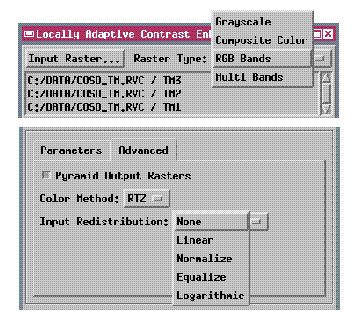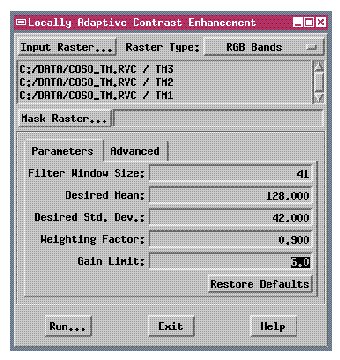Locally Adaptive Contrast Enhancement Filter for RGB and Multi-Band Raster Sets
V5.60 –– April 1997
| The Locally Adaptive Contrast Enhancement (LACE) filter can now be applied not only to a single grayscale raster, but to an RGB raster set, a color composite raster, or to a raster set with more than three component rasters (multi bands). The LACE filter is designed to improve local contrast for images that include both very dark and very bright areas. | The Multi Bands option performs a principal components transformation on the input raster set and applies the contrast enhancement to the first principal component raster. The filtered first principal component is then used in the reverse transformation to produce a filtered version of each input raster band. |
| All of the LACE filter operations can be launched from a single user interface. The Composite Color and RGB options apply the local contrast enhancement to a computed intensity raster (average of the brightness in the Red, Green, and Blue components). Several choices are offered for converting the filtered image back into RGB color space. | The LACE filter process now allows you to redistribute the values in each input raster prior to application of the filter. The input redistribution choices parallel the auto-contrast enhancement choices available in the Spatial Data Display process. |
Portion of a Landsat TM scene (Bands 3, 2, 1 as RGB) with normalized contrast enhancement. Dark lava flows and bright salt flats reveal little local detail. |
Same scene with the RGB LACE filter applied with Normalized input redistribution. The final image is a weighted average of the LACE filter output (90%) and the original image (10%). Enhanced contrast in dark and light areas brings out significant surface detail throughout the image. |
|
|



